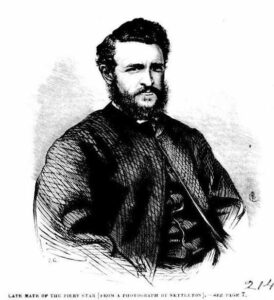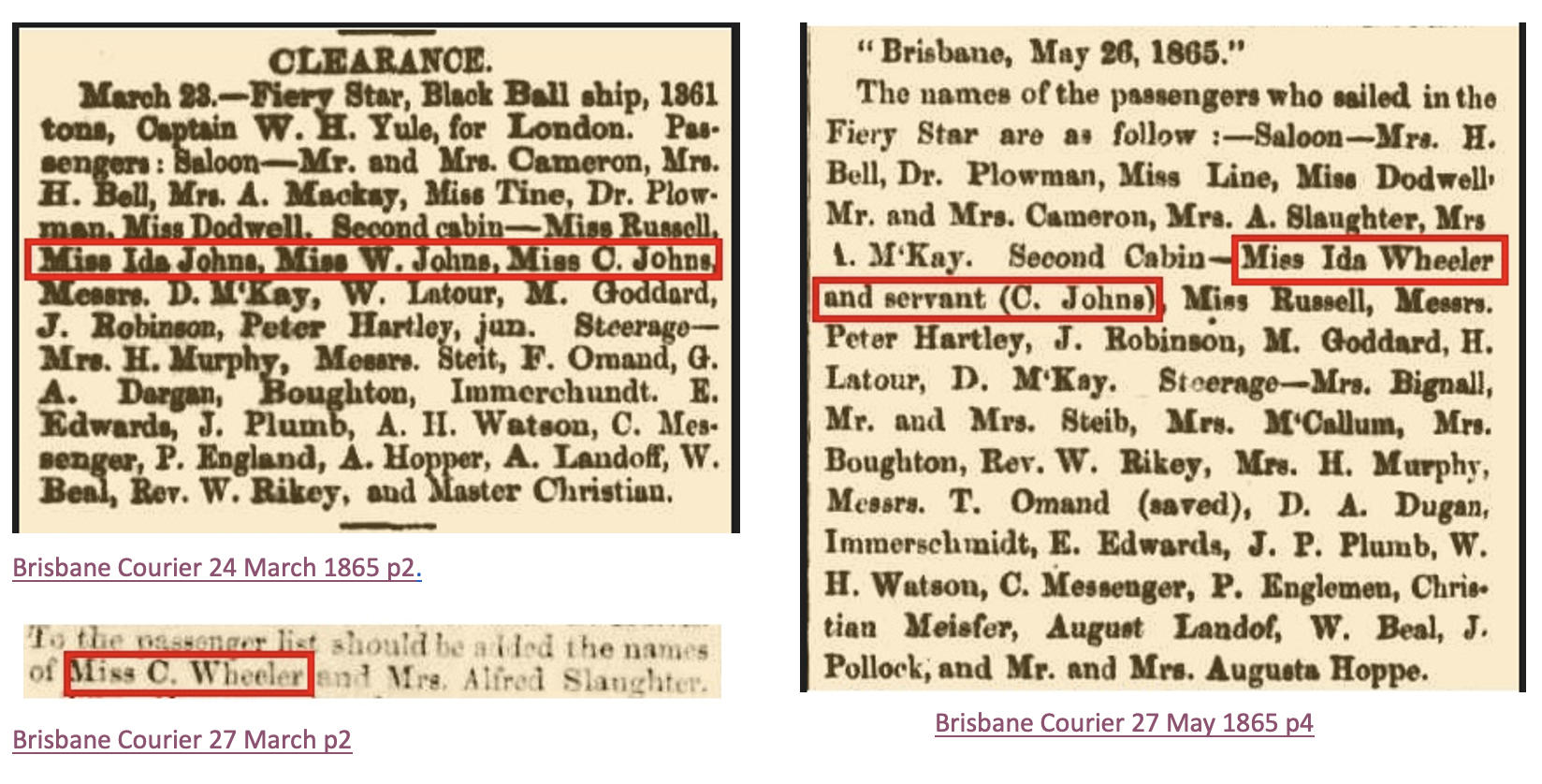Three different passenger lists, so who died on the Fiery Star journey of 1865?
In April 1865 a dramatic, unforgettable sea tragedy occurred which haunted many for years. The Fiery Star, formerly the Comet, which brought immigrants to Queensland in 1863 and 1864, was making a return journey to England when disaster struck. Its wool cargo spontaneously combusted; the fire was devouring the ship as it approached the Chatham Islands near New Zealand. The highly respected Captain W H Yule decided to abandon ship taking seventy-two people: the cabin passengers and others who could fit into the boats. Many of the crew and remaining passengers stayed onboard. The sense of inevitable doom linked to the ship’s two names was magnified in the minds of superstitious sailors.

Grosse, Frederick, 1828-1894, engraver. June 24, 1865. Shows sailing ship with fire on deck, rowing boats from sailing ship “Dauntless” rescuing crew. State Library of Victoria.
By the following day the boats had disappeared in the wild seas, frustrating the plan for the ship and the boats to remain within close vicinity.

W. C. Sargeant, Esq. Australian news for home readers 25 July 1865 p4.
Those who remained behind, including the first mate W. C. Sargent, fought the fire and built a raft. The prospects were increasingly hopeless when the Dauntless came to their rescue. The Fiery Star’s crew and remaining passengers boarded in time to watch their vessel burn to the waterline.
The Dauntless reached Auckland on 15 May and news of the disaster spread around the world. Although most passengers were from Queensland, their origins were mostly in the British Isles or Europe.
Why focus on the Fiery Star list?
Wheeler family monument in England.
Around 2000, before Trove historical newspapers, we were looking for Ida Wheeler, a seven-year-old, who was to travel to England with a servant, Miss Johns, to attend school. The researcher had visited an English family grave where the headstone recorded her date of death at sea without a ship name.
Who survived?
The date focused on the Fiery Star and the departure list published in the Brisbane Courier. There were at least three different versions marked by errors and omissions.[1],[2],[3] The first version was the one published in overseas newspapers e.g. London Times.
The first Brisbane Courier departure list provided three names with the surname Johns, one of whom had the first name, Ida. The corrected list three days later provided additional names including that of Miss C Wheeler, another name confusion. Two months later, after the return of the Dauntless, Ida Wheeler and her servant, Miss C Johns were finally correctly named.
Note the other incorrectly recorded names between the lists, especially if they were foreign: Tine/Line; Steit/Steib; G A Dargan/D A Dugan; Immerchundt/Immerschmidt; England/Englemen; Hopper/Hoppe; Landoff/Landof; Master Christian/Christian Meisfer. There was a tendency to anglicise names in the errors created.

Three of the newspaper reports in the Brisbane Courier of 24 March, 27 March and 27 May 1865.
How reliable are newspaper passenger lists?
The reliability varies. What is even more frustrating is that for so many coastal and overseas lists, the only source is the newspaper list. Steerage passengers, usually the greatest number on a ship, are often just a total number without names. When it is possible to compare lists, there are often differences and omissions to the point where it is hard to trust any specific list completely.
Are original shipping lists correct?
We rely on original lists to be the most accurate records, but these are not always correct or even preserved. Ancestry and Findmypast both have the index and passenger names from ‘UK and Ireland, Outward Passenger Lists, 1890-1960’. The database enables a check of those leaving the UK with those arriving in Australia by using the British and Australian lists in conjunction. It’s a valuable point of comparison. George Alfred Carthew Wright, known more commonly as George Wright, could not be found for years. Eventually a search of a Croydon (Qld.) hospital list indicated he had arrived on the Merkara around the early 1890s. He was easily found on the UK lists outward as G A C Wright travelling to Normanton by searching with his surname, the ship name and a date range. The Queensland list, however, recorded him as Mrs. G S Wright, one of two passengers disembarking at Thursday Island. We know from subsequent events that he then made a coastal trip to Normanton to join his brothers in a mining venture.
What are other ways to find an immigrant arrival?
- Search for spelling variants. Immigrants themselves used name variants either deliberately or because of literacy and a lack of standardised spelling.
- Check for updates at Queensland State Archives. It has digitised and placed online a number of indexes, sometimes with lists. Even if the lists are not immediately available, they can be accessed via an online enquiry or a visit to Queensland State Archives.
- Explore National Archives of Australia. Online series J715: Ships passengers lists – Brisbane – inwards – Jan 1852 – 31 Dec 1964 which includes a number of 1860s’ lists otherwise unavailable.
- Check immigration records of other Australian colonies/states. Immigrant destinations are not necessarily where they land. Immigrants may have taken a convenient passage to a port and then used a coastal vessel to reach the end of their journey. Governments also put assisted passengers on vessels to places where labour was required. Circumstances can appear different when newcomers land. A stonemason might quickly realise there will be little work for him in Rockhampton despite the advantageous assisted passage conditions.
- Research family histories and pioneer registers. They may draw on records only a family holds but always cross-check as they can also be used to enhance or hide an unpleasant truth. They may even be based on unfounded suppositions, easy to support in a time of the traditional naming pattern, so that the same names are endlessly repeated. A free settler may have been a convict.
- Explore obituary and anniversary notices in Trove historical newspapers. Again, they may contain errors so should be cross-checked.
Overseas and internal immigration mark significant transitional points in families’ lives and so are not only a source of interest but also sometimes of extreme frustration. There can be many obstacles in tracing these records but also some rewards in persisting with the exploration as the search for Ida Wheeler shows.
[1] Brisbane Courier 24 March 1865 p2
[2] Brisbane Courier 27 March p2
[3] Brisbane Courier 27 May 1865 p4

Thanks Stephanie, my ancestor came to Moreton Bay on the 1864 arrival.
Norah, There were interesting people on the ship, including your family obviously. One was John O’Keeffe responsible for many 19th Century Brisbane buildings. He said:
“This vessel was paid the greatest honour ever paid to an emigrant vessel leaving for Australia. At Queenstown [now Cobh] the ‘home’ fleet was there, the crew manned the yards, and cheered three times three, while the band played popular airs.” Brisbane Courier 10 June 1913 p6